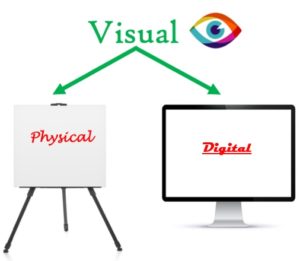By Dr. Ken Broda Bahm:

These days we’re pretty used to digital displays. What we once did with a marking pen, or later with a computer and printer, can now be displayed more easily, and often more impressively, on a screen. All of us are used to seeing our news (and reading our blog posts) on a screen; students and businesses are used to learning via PowerPoint and, increasingly, judges and jurors are used to seeing evidence and demonstrative exhibits on screen as well. A couple of weeks ago I was listening to a judge give a talk, and he said, “It is time to ditch the boards,” meaning the foam-core blow-ups that are displayed on an easel in a courtroom. “When the courtroom allows for use of a digital-display system, or has that already built in, just use that.” I disagree.
While digital presentation has many advantages, I believe that the preprinted boards, physical models, and even the flip chart drawings created on the fly still play a role. That is because in the difficult task of gaining and holding on to the attention of a juror or a judge, it helps to use all of your tools. It is easier to understand a point when it has a visual component (something we demonstrated in our own Visual Persuasion Study), and it is easier to pay attention to that visual component when it is varied. So being multi-modal when it comes to how you get those visuals to your decision makers should be considered a best practice. In this post, I’ll look at the reasons why.
Digital Graphics Are Great Because…
They’re Easy. It takes a fraction of the time to create content to display to a group, and at trial, that ability to work on-the-fly can be a lifesaver.
The Courts Increasingly Expect Them. Courtrooms are notoriously lacking a single focal point that everyone can easily see, but the use of multiple screens, and even individual juror monitors, has made this easier. Understand and use the system correctly and you’ll make the clerk very happy.
Because People Are Used to Learning That Way. We spend a large portion of our day looking at screens. So it is no longer a novelty or, if it ever was, a sign of “deep pockets” that one is using sophisticated graphics. These days, we want and expect the digital graphics to draw us in.
But Physical Graphics Are Also Great Because…
They’re Interactive. Yes, you can manipulate an image on the screen, or use a mouse or a laser pointer to direct attention to a specific part. But that is not the same thing as walking up to the physical blow-up and marking on it.
They’re Tangible. The physical presence of the board can be an asset. While the screen can be shut off or move on to the next image, the board can be left up as a background reference.
They Gain Attention. In a 2018 presentation to the Missouri Association of Trial Attorneys, Todd C. Werts explained the results of his survey of trial attorneys, and the finding that attorneys still have a strong desire to use something that isn’t on the screen: “From these discussions, a common theme emerged. That is, the value of using traditional board-and-easel exhibits, flipcharts, white boards, and other tangible things that have a physical substance beyond just appearing on-screen.”
And Using Both is Best
That last reason is why digital display along with physical exhibits is the right combination. They complement each other. As Mr. Werts continued, “These tangible presentation devices give the jury something to connect with and can help to disrupt the lullaby effect that can be caused by too much time with a video screen.”
Another explanation of this complementarity comes from Paul Unger of Affinity Consulting, in a Colorado Bar Association publication.
Remember to use white boards, chalk boards, easels and enlarged pictures from time to time. There are multiple reasons for this. First, a jury can become bored with PowerPoint and a movie screen just as easy as they can with a chalk board. We know from the television industry that changing the frequency of angle-shots within the same visual scene improves memory recognition. Count the number of angle changes within the same visual scene in a sitcom from the 60’s versus a sitcom (or reality shows) created today. This teaches us that people are easily bored. So mix up the media. The second major reason for not relying on PowerPoint 100% of the time is that sometimes you want an illustration, timeline or photographs sitting on an easel for a long period of time so the jury can look at it for clarification or other reasons. If you have a blow-up, you can do that and also show PowerPoint slides or images through Sanction.
______
Other Posts on Trial Graphics:
- Feed Your Millennials Visual Information
- Use Cartoon-style Graphics to Persuade
- Go Ahead and Use a Flip Chart